THE WORLD – REALITY
Panel C
Exploring Spirituality
Rosie Jackson 2007
Acrylics on canvas, 100 x 120 cm
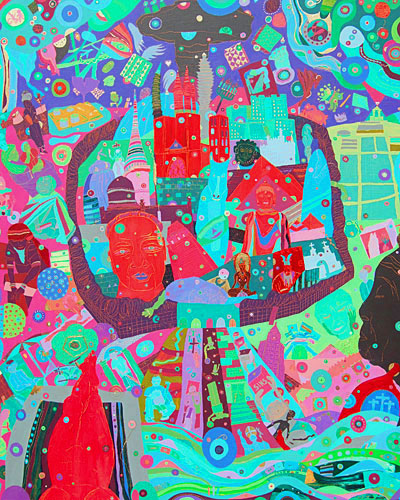
Rosie Jackson 2007
Acrylics on canvas, 100 x 120 cm
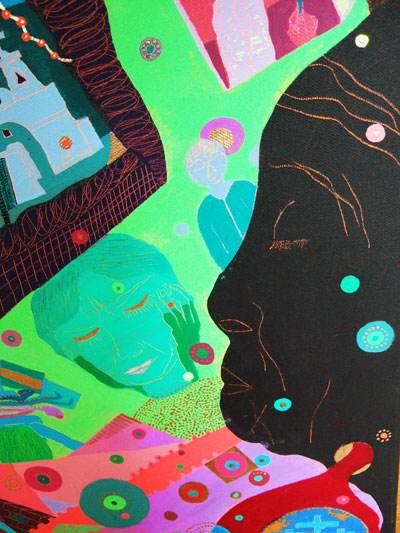
This detail shows two troubled Global Villagers. The large facial profile belongs to a woman from the Congo who turns to prayer in the face of her overwhelming feeling of helplessness.
The other is a Rumanian woman who is plagued by migraine and who pressurises herself to live within rigid structures. A corner of the impenetrable Holy Citadel, surrounded by barbed wire, is visible in the background.
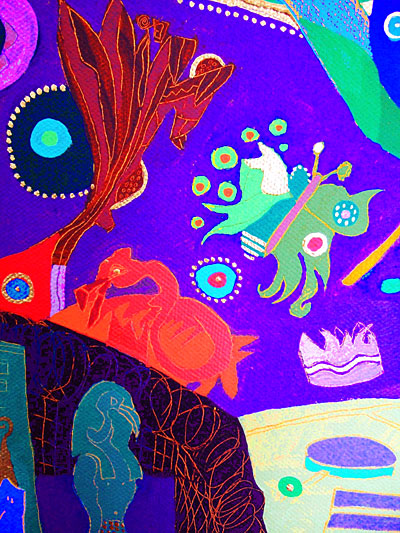
This detail illustrates some of the consequences of the violence which we have inflicted on our planet and on the creatures which inhabit it: the butterfly and the plant are stunted and deformed in growth, and the bird cannot fly because its wings have been damaged by pollution.
The Egyptian falcon god, Horus, stands behind the barbed wire surrounding the Holy Citadel. He looks towards the green area on the other side, where thousands of nuclear waste canisters are stored.
However, symbols of growth, potential and compassion also appear on this panel. Here we see a crown, representing the seventh chakra which is concerned with spirituality
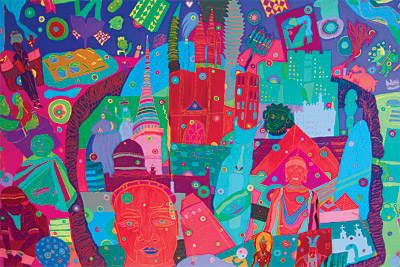
This detail shows an impenetrable holy citadel surrounded by barbed wire (see text below) and the following Global Villagers:
Global Villager 32: An Indian woman carrying firewood across the square in Chandigarh. She is not part of the city's exuberant bustle but focusses instead on its crumbling architecture
Global Villager 50: A baby boy from Pakistan, in the arms of his mother after escaping an earthquake, crying for more milk and sensing his mother’s fear
Global Villager 27: An old Indian beggar woman from Varanasi, in a green headscarf, who will soon die of starvation because her fear of pain prevents her from moving
Global Villager 30: A universally despised ‘untouchable’ Indian woman from Bombay, resigned to a menial existence unloading bricks as punishment for her bad karma
The almost impenetrable religious citadel consists of many imposing buildings – mosques, cathedrals, palaces and minarets – and includes statues of notable personalities or gods, including Mao, the Black Tara, a holy cow, Confucius, Buddha and the three Egyptian deities, Thoth (Ibis) the god of knowledge, Nut the goddess of the sky and Horus the falcon god.
The citadel is surrounded by barbed wire, separated by high walls and inhabited by unseen worshipers who submit to dogma, exercise limitation, regard themselves as imperfect or sinful and who fearfully succumb to higher authority. Nevertheless, some of them are beginning to ask themselves questions: a green search-arm on the right and a blue one in the centre are trying in vain to end separation and reach into other sections of the citadel through holes in the walls.
The citadel is crowned by a dark, threatening nuclear mushroom fired by thought-prisons – huge boxes of negative energy. It is flanked by miles of nuclear waste on the right and it borders an oil refinery on the left. The consequences of the violence we have so far inflicted upon ourselves and our planet are represented by the deformed flowers, a bird injured by pollution and a stunted butterfly.
However, they are accompanied by symbols of potential growth and compassion: a crown representing the seventh chakra, two lovebirds sitting on the barbed wire, a huge flourishing gingko leaf (the only tree to survive Hiroshima) which absorbs the poisonous fumes, and the golden centre of every floating cell.
So far, traditional religions have failed to solve the world’s problems. The conviction that one’s own religion is the best, or the most valid, is potent fodder for conflict. The challenge which lies before all the Global Villagers is to embark upon the exciting inner journey towards a clear awareness of their own behavioural patterns, to acknowledge their own ‘sensitive spots’ and to realise that hate is based on projections, lack of information or insufficient awareness.
When their enemy images and their concepts of ‘good’ and ‘evil’ have dissipated, when they have rid themselves of their role as the victim and assumed their role as gods and goddesses, they will critically be able to investigate existing rules or principles (including religious ones) and judge whether they ‘work’ for themselves and for the world at large.
This does not necessarily involve rejecting existing religious convictions: it means acting with compassion and expanding one’s belief into a new, universal, spiritual ‘umbrella’ based on the ‘We-are-all-One’ principle and – in Ghandi’s words – “being the change we wish to see.” The blue footprint (top right) is an invitation to ask ourselves: “What sort of tracks do we want to leave behind us?”
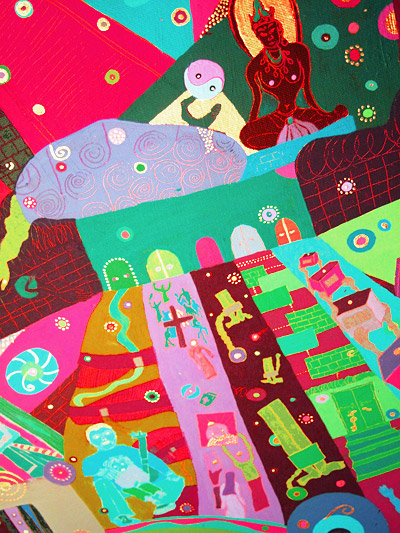
This detail shows the five roads leading to the five entrances to the Holy Citadel.
All of them are difficult to navigate: two are strewn with obstacles such as walls or locked doors: the purple path only admits worshipers who participate in processions, conduct certain rituals and adore specific objects.
Permission to travel the other roads is only granted to those who accept self-imprisonment (symbolised by legs in salvation-chains) or to those who are accompanied by a box of sins.
The citadel is already full of unseen worshipers who submit to dogma, exercise limitation, regard themselves as imperfect or sinful and who fearfully and unquestioningly succumb to higher authority.